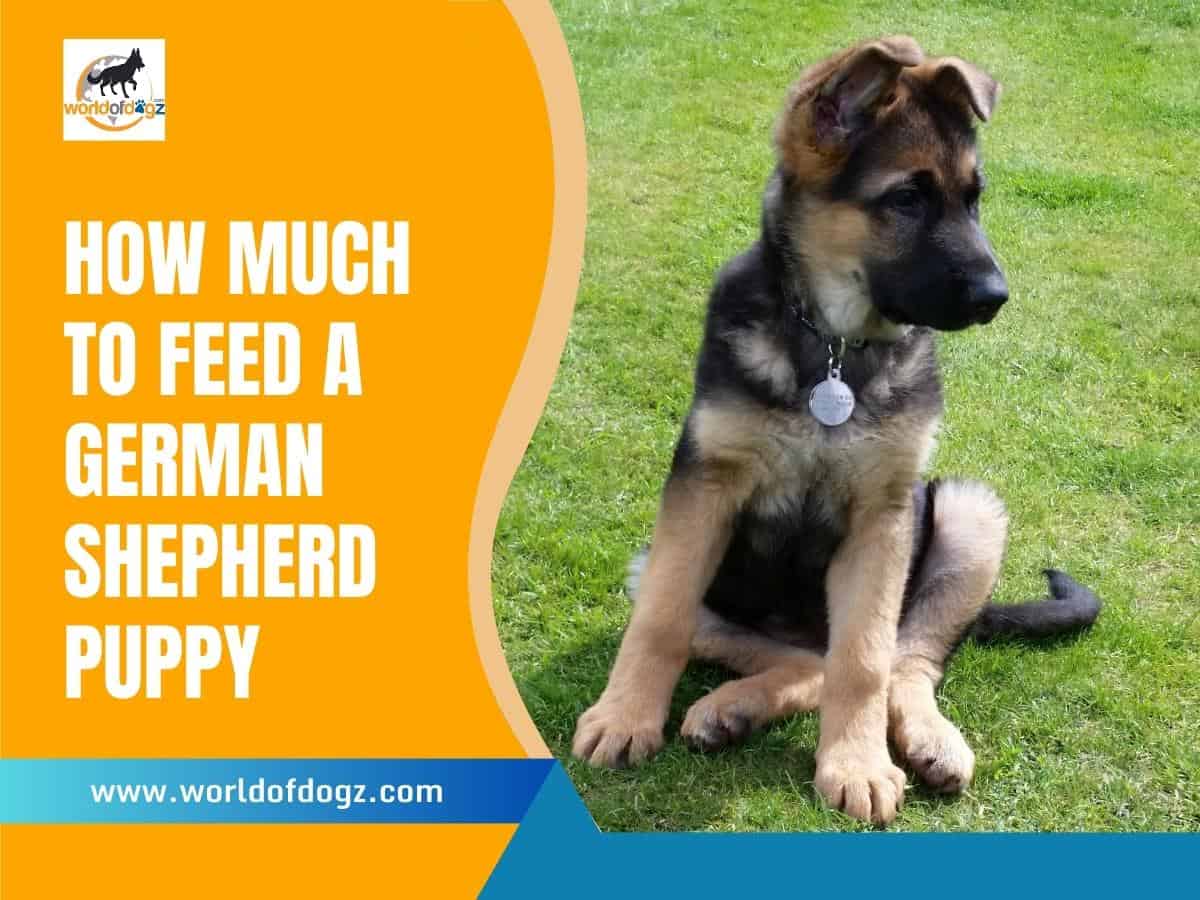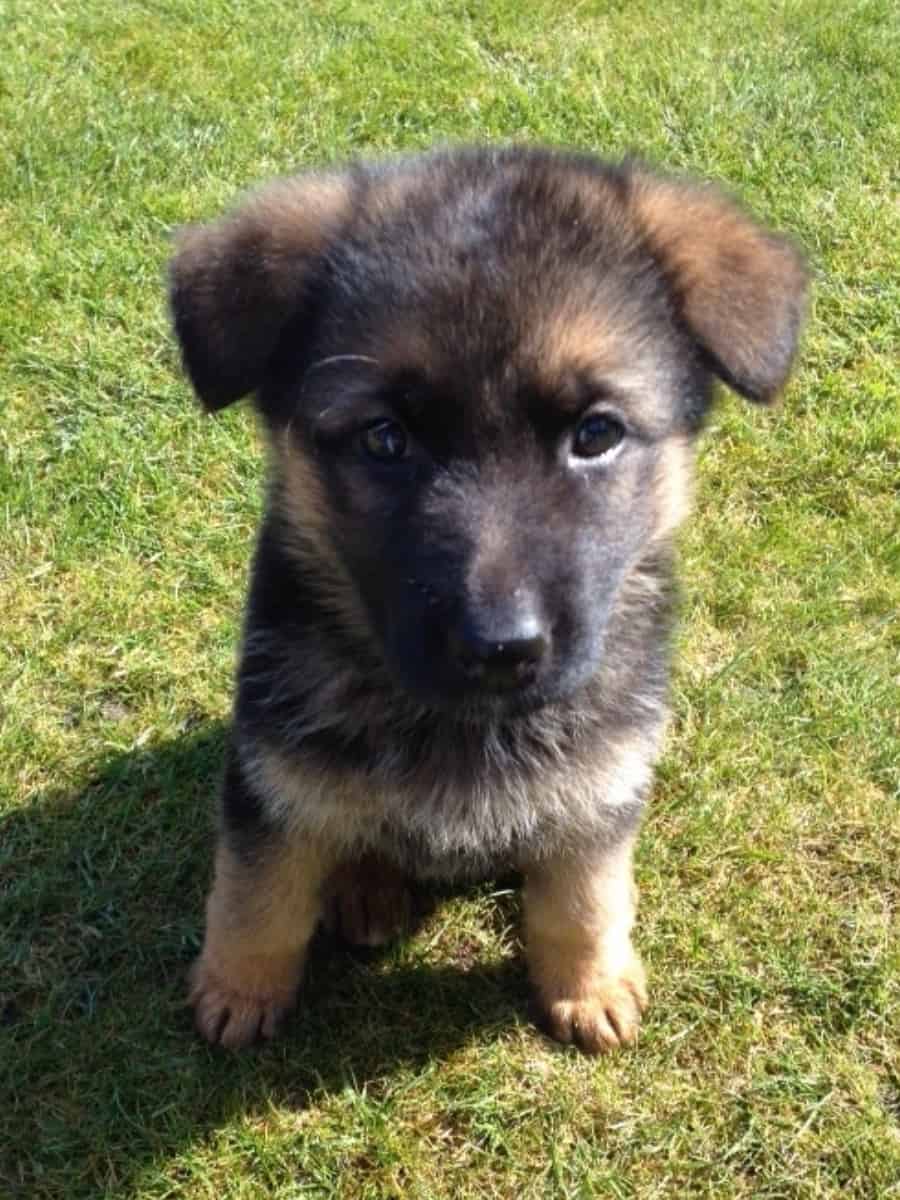One of the most common questions new German Shepherd puppy owners ask their vets is, “How much should I feed my German Shepherd puppy?” If you’ve found yourself asking your vet that question, you probably got an answer similar to this one:
A German Shepherd puppy will eat ½ a cup of food daily when weaning starts at around 4-6 weeks and up to 4 or more cups by six months at the onset of adolescence. By 12 months, the amount will begin to adjust to the usual adult GSD amounts, around 3-6 cups, depending on your dog’s activity level.
Feeding your German Shepherd properly during puppyhood guarantees a healthy and quality adult life. So, in the rest of the article, I’ll briefly recap the nutritional requirements and how much to feed a German Shepherd puppy for optimal health.
Keep your eyes peeled for my German Shepherd puppy feeding tips later!

Nutritional Requirements for German Shepherd Puppies
Quantity and quality are core aspects to consider when feeding your German Shepherd puppy. Nutritious food for your puppy goes hand in hand with how much you give to the pup.
Puppy food quality translates to the inclusion of the recommended nutritional requirements. Like adult German Shepherds, puppies need their food with the right nutritional requirements. Differently, however, puppies need higher nutritional content in their food than adults.
Before telling you how much to feed your GSD puppy, here’s a quick summary of your puppy’s nutritional requirements:
- Proteins and essential amino acids – 22.5% minimum.
- Fat and fatty acids – 8.5% minimum.
- Energy foods – According to the puppy’s body weight, usually double the amount of calories per pound of body weight as an adult GSD.
- Minerals – The recommended quantities for all 12 mineral requirements.
- Vitamins – Small quantities of recommended vitamins, including A, B, C, D, E, and K from dog-safe fruits and vegetables.
- Water – ½-1 ounce per pound of body weight. Once you wean your puppy, leaving a bowl of water around is allowed.
Feeding your German Shepherd with solid food begins after a transitional weaning period. This transition helps your pup move from exclusively nourishing from the mother’s milk to eating solid dog food. As such, it is important to revisit a few points on weaning your German Shepherd puppy.
Weaning Your German Shepherd Puppy
If you wonder how much to feed a German Shepherd puppy, it only means your pup is ready to wean and transition to solid food.
You should introduce your German Shepherd puppy to weaning once its tiny teeth appear, around 3-4 weeks of age.
At this age, the mother is more reluctant to feed the pups because their teeth make suckling uncomfortable. Besides, feeding a litter of growing pups can also be energetically draining for the mother.
Away from that, however, your puppy needs to start building a strong immune system with proper nourishment.
So, at 3-4 weeks, you can leave around a bowl of a puppy milk replacer so your GSD puppy can start licking and drinking it gradually.
Puppy milk replacers mimic the mother’s milk in their formula. They have added proteins, fat, minerals, vitamins, probiotics, and prebiotics to enhance immunity, gut health, and better digestion.
When you use puppy milk replacers, go for brands with proven quality and ensure proper handling. Talking to your vet first is always ideal.
Once your puppy is eating more of the milk replacer, you can add a bit of canned puppy food to the milk. You should then decrease the milk amount gradually until the puppy can eat the canned food without the milk. That should be about the sixth week.
By now, you can begin introducing your puppy gradually to dry kibble by mixing a bit of kibble with moist canned food. Your German Shepherd puppy should be okay eating dry food by the time he is 8 weeks old. This is the age most puppies go to their new homes.
Once your puppy is fully weaned, you must adopt a regular weaning schedule to prevent weight issues.
Having a planned German Shepherd puppy feeding schedule means we can now talk about how much to feed your puppy.

How Much to Feed a German Shepherd Puppy
Veterinarians recommend feeding your puppy with quality commercial puppy food. To help you out, good puppy food manufacturers include a feeding guide with details on how much to feed your puppy and how many times daily.
Also, puppy food manufacturers will approximate your puppy’s daily food requirement based on an estimated adult weight. From their projected adult weight, a German Shepherd puppy will grow to around 50lb-90lb (22.7kg-40.8kg). So, the amounts on a German Shepherd feeding chart are distributed based on that weight range.
Going by the recommendations from some popular puppy food brands, a German Shepherd puppy will eat between ½ cup and 4 cups of food depending on their age in months and the estimated weight at maturity. You should give the recommended amount for your puppy divided into 4, 3, and 2 portions as your puppy ages.
Since not all German Shepherd puppies are the same, the best way to know how much to feed your puppy is to follow the feeding guidelines on your puppy’s dog food label.
To give you an idea, I picked two of my favorite puppy food brands. One is made specifically for German Shepherd puppies, Royal Canin German Shepherd Puppy Dry Dog Food:
- FORMULATED FOR PUREBRED GERMAN SHEPHERDS: Royal Canin German Shepherd Puppy Dry Dog Food is designed to meet the nutritional needs of purebred German Shepherd puppies 8 weeks to 15 months old
- SPECIALIZED SHAPE: Unique kibble shape is designed for a German Shepherd’s long, strong muzzle to encourage chewing
- HEALTHY DEVELOPMENT: An exclusive complex of antioxidants, including vitamin E, helps protect puppy development of the immune system
- HEALTHY DIGESTION: Aids digestion with highly digestible proteins and specific fibers to promote optimal stool quality
- BONE AND JOINT: Maintains bone and joint health with glucosamine and chondroitin to support large breed bod
Prices pulled from the Amazon Product Advertising API on:
Product prices and availability are accurate as of the date/time indicated and are subject to change. Any price and availability information displayed on [relevant Amazon Site(s), as applicable] at the time of purchase will apply to the purchase of this product.
And the other is for any large breed puppy, Purina Pro Plan Large Breed Dry Puppy Food:
- One (1) 34 lb. Bag - Purina Pro Plan Large Breed Dry Puppy Food, Chicken and Rice Formula
- Formulated to support an appropriate growth rate for large breed puppies
- Glucosamine supports developing joints and cartilage
- Vitamin A and omega-6 fatty acids to nourish skin and coat
- High protein formula, with real chicken as the first ingredi
Prices pulled from the Amazon Product Advertising API on:
Product prices and availability are accurate as of the date/time indicated and are subject to change. Any price and availability information displayed on [relevant Amazon Site(s), as applicable] at the time of purchase will apply to the purchase of this product.
Both brands meet the minimum content recommendation for protein and fat nutrients, which are essential for proper puppy growth. The Royal Canin German Shepherd puppy food has a protein content of 28% and a 14% fat content. The Purina Pro Plan Large Breed puppy food has 28% protein and 13% fat.
We’ll assume that your German Shepherd has an estimated adult weight of around 75lb (34kg). Here’s how much to feed your puppy with the Royal Canin and Purina brands at different months of puppy age.
| Estimated Adult Weight | Puppy Food Brand | Puppy Age | ||||
| 1-3 Months | 4-5 Months | 6-8 Months | 9-11 Months | 12 Months | ||
| Around 75lb (34kg) | Royal Canin | 2⅞ – 3½ cups | 3⅞ cups | 4⅜ cups | 4 cups | 3⅝ cups |
| Purina | ⅔ – 2 cups | 1¾ – 3⅓ cups | 1½ – 3¼ cups | 2¾ – 4 cups | 3 cups | |
Note: Royal Canin specifies that an 8oz cup = 91g, while the same cup size has 106g for the Purina brand.
As you can see, the same puppy may need more of a particular food brand and less of another brand. That depends on the caloric content in each food type.
Remember that this only refers to a GSD puppy with a predicted 75lb adult weight. So, you might want to calculate your puppy’s estimated adult weight, then use the feeding chart on your puppy’s food to see how much you should feed him.
On that note, a few tips on how much to feed our German Shepherd puppy are opportune.

Tips for How Much to Feed Your German Shepherd Puppy
Whichever food brand you go for, some puppy feeding tips are worth considering when deciding how much to feed a German Shepherd puppy daily.
1. Divide Your German Shepherd Puppy Food into Portions
Although German Shepherd puppies need plenty of food, you should not give them all the food in one large portion.
Dividing the amount helps your pup adjust to solid food in the weaning weeks. In the later growth months, giving food in smaller amounts also enhances digestion and aids weight management.
The food should be divided into 4 portions when the puppy is below 2 months, 3 portions at 2-3 months, and 2 portions at 4 months and above.
2. Always Consider Your Puppy’s Activity Level
Dog Food Manufacturers give feeding guidelines based on the nutritional needs of a German Shepherd puppy with an average activity level. If your puppy has a lower or higher activity level, you should adjust the portions accordingly.
Talk to your vet if uncertain.
3. Do not Overfeed Your German Shepherd Puppy
Your German Shepherd puppy may show extra appetite in the growth and development months or ask for more food with their puppy dog eyes. Desist from giving in!
Research confirms that overnutrition negatively affects your puppy’s health during the growth months. Specifically, your puppy can:
- Develop bone and musculoskeletal disorders. A study found that 66% of participating puppies had skeletal disorders due to overnutrition. A German Shepherd puppy in the study with 38kg (83.8 pounds) of body weight at 11 months showed advanced lameness in the hind legs.
- Develop osteochondrosis. This bone and cartilage development disorder can cause your overweight German Shepherd puppy to have limb deformities.
Additionally, health problems related to German Shepherd puppy overnutrition cause adverse effects on your adult GSD.
So, if you feed your German Shepherd puppy 3 cups of food while the label says you should give only 2 daily, you are creating a recipe for a lame and sickly adult GSD. And you sure don’t want that, right?
Take-Home Message
German Shepherd puppies have a right to a good amount of food by virtue of being in the rapid growth and development stage. As such, veterinarians encourage you to follow the feeding guidelines on commercial puppy food labels to ensure you feed the correct amounts.
Your German Shepherd puppy may have unique needs based on their activity level or other growth factors. For that reason, always consult your puppy’s vet when in doubt. After all, it’s the health of your loyal and loving furry friend we are talking about here!
Related Posts You May Like:







